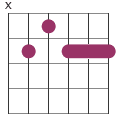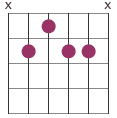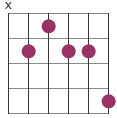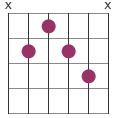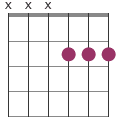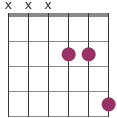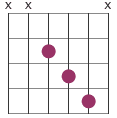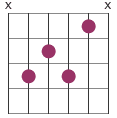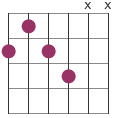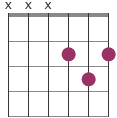Funk chords
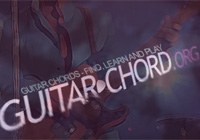 A central part of funk guitar playing is to alternate the strumming of tones with strumming on muted strings, which will result in scratch rhythms. Parts of songs actually use more muted strokes than not. When it comes to amp effects and funk, many advocates compression because it gives the snappy sound that often is wanted in this style. Another effect is the wah wah, that can bring some of that 70's funk vibes.
A central part of funk guitar playing is to alternate the strumming of tones with strumming on muted strings, which will result in scratch rhythms. Parts of songs actually use more muted strokes than not. When it comes to amp effects and funk, many advocates compression because it gives the snappy sound that often is wanted in this style. Another effect is the wah wah, that can bring some of that 70's funk vibes.
Chords (movable)
9
9 (no5)
13
7#9
Comments
The 9th is are one of the first chords you should learn if you are attempting to play funk on the guitar. An easy method to get started and get some funky sound from your guitar is just to shift between a 9th and a 13th chord. Only one finger needs to be added. You could also slide into the 9th chord from one fret below or above. The movable 9th chords is perfect for slide one semi-note as in the following example with a D#9 slide into E9:
Another course is via the standard barre chords and one possible sequence is Am7 - Dm7.
Funk chords voicings
9
13
13
7
7
m7
Comments
The chord diagrams above lacks indication of which tone it's and only presenting the chord shape. Since these chords are movable you can use them for all tones and if you are unsure of fret positions, see the lists below.
These chords are all alternatives of more standard shapes of 9th, 13th, 7th and minor 7th, and delivers a funkier sound.
Some of these voicings exclude the root note. This may sound strange, but one way to comprehend this is to look at these chords as fragmented versions of the typical 9th chord. The following list is more specific:
B9: XXX222 (or X21222)
C9: XXX333 (or X32333)
D9: XXX555 (or X54555)
E9: XXX777 (or X76777)
F9: XXX888 (or X87888)
G9: X X X 10 10 10 (or X 10 9 10 10 10)
B13: XXX224 (or X21224)
C13: XXX335 (or X32335)
D13: XXX557 (or X54557)
E13: XXX779 (or X76779)
F13: XXX88 10 (or X 8 7 8 8 10)
G13: X X X 10 10 12 (or X 10 9 10 10 12)
Bm7: XXX232 (or X2X232)
Cm7: XXX343 (or X3X343)
Dm7: XXX565 (or X5X565)
Em7: XXX787 (or X7X787)
Fm7: XXX898 (or X8XX898)
Gm7: X X X 10 11 10 (or X 10 X 10 11 10)
Chord progressions
Examples of progressions suitable for funk guitar:
F9 - G9 - F#9 - F9
C9 - G#9 - G9
C#m7 - G#m7 - B9
Bm7 - E9 - D9
To create some extra interest, you can slide the high part of the chords up two frets and back, for example, in the second bar at each chord. In short notation tab: Bm7: 7 X 7 7 7 X / X X 9 9 9 X / X X 7 7 7 X; D9: X 5 4 5 5 5 / X X X 7 7 7 / X X X 5 5 5; E9: X 7 6 7 7 7 / X X X 9 9 9 / X X X 7 7 7.
Learn from video
Chord progressions in the funk genre are often static, meaning they stays on the same chord for a long time. But you can add variations such as G9 + G13 + G7#9 (in this case, you only add litte finger for G13 and move it for G7#9).
Funk as genre
Funk arose as a music style in the 1970s and was originally associated with black music. Getting familiar with the genre and how funk music sounds will also benefit your playing. Listen to artists such as James Brown, Marvin Gaye, Prince and Curtis Mayfield to get a sense of it. These are all examples of funk combined with soul. Funk can also be combined with blues (Kenny Wayne Shepherd and Johnny Lang are two names among many), or with rock (Red Hot Chile Peppers is a known example).
Drum tracks
A fun way to practice is to use jam tracks. The following jam tracks are for funk and involves only drums.
